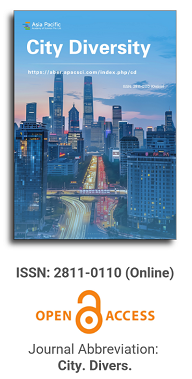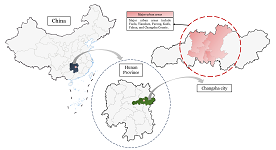
Asia Pacific Academy of Science Pte. Ltd. (APACSCI) specializes in international journal publishing. APACSCI adopts the open access publishing model and provides an important communication bridge for academic groups whose interest fields include engineering, technology, medicine, computer, mathematics, agriculture and forestry, and environment.

As China's pillar industry, the property market has suffered a considerable impact in recent years, with a decline in turnover and many developers at risk of bankruptcy. As one of the most concerned factors for stakeholders, housing prices need to be predicted more objectively and accurately to minimize decision-making errors by developers and consumers. Many prediction models in recent years have been unfriendly to consumers due to technical difficulties, high data demand, and varying factors affecting house prices in different regions. A uniform model across the country cannot capture local differences accurately, so this study compares and analyses the fitting effects of multiple machine learning models using February 2024 new building data in Changsha as an example, aiming to provide consumers with a simple and practical reference for prediction methods. The modeling exploration applies several regression techniques based on machine learning algorithms, such as Stepwise regression, Robust regression, Lasso regression, Ridge regression, Ordinary Least Squares (OLS) regression, Extreme Gradient Boosted regression (XGBoost), and Random Forest (RF) regression. These algorithms are used to construct forecasting models, and the best-performing model is selected by conducting a comparative analysis of the forecasting errors obtained between these models. The research found that machine learning is a practical approach to property price prediction, with least squares regression and Lasso regression providing relatively more convincing results.
A place to commemorate Smyrna refugees
Vol 6, Issue 1, 2025
Download PDF
Abstract
The paper delves into the role and power of places of memory in preserving and strengthening the collective memory and identity of Greeks who originated from Asia Minor and specifically Smyrna. Historical data are presented regarding the persecution of this community and the triptych “place-collective identity-collective memory” is thoroughly studied. Through semi-structured interviews, and participatory design methods, with the collaboration of users, landscape architect, agronomist, and sociologist, the landscape design proposal aims to create the First Nationwide Open-Air Museum of Smyrna in Thessaloniki, Greece. The new land uses are based on the shaping and preservation of the collective memory and identity of Smyrnaeans, and the coexistence of historical and cultural elements in a modern design canvas. Users and visitors perceive the landscape as a document of the Smyrnaean culture, which narrates the history of their community, allowing them to define their particular identity and identify themselves as “us”.
Keywords
References
1. Stoffberg H, Hindes C, Muller L. South African landscape architecture. Unisa Press; 2012.
2. Jacques D. The rise of cultural landscapes. International Journal of Heritage Studies. 1995; 1(2): 91-101. doi: 10.1080/13527259508722136
3. Radstone S. What Place Is This? Transcultural Memory and the Locations of Memory Studies. Parallax. 2011; 17(4): 109-123. doi: 10.1080/13534645.2011.605585
4. Müller L. Landscapes of Memory: Interpreting and Presenting places and parts. In: South African Landscape Architecture. Unisa Press; 2012. pp. 7-26.
5. Horn C, Wollentz G, Di Maida G, et al. Introduction. In: Places of Memory: Spatialised Practices of Remembrance from Prehistory to Today. Archaeopress Arcaeology; 2020. pp. 1-7.
6. Bourdieu P. Distinction. Harvard University Press; 1984.
7. James A. Memories of Anatolia: generating Greek refugee identity. Balkanologie. 2001; 5(1-2). doi: 10.4000/balkanologie.720
8. Saroglou SΑ. The refugees of Asia Minor and their contribution to the development of Greece (Greek). In: The Hellenism of Asia Minor-The national contribution and its historical survival (Greek). Βάνιας; 1991. pp. 139-144.
9. Stelaku V. Space, Place and Identity: Memory and Religion in two Cappadocian Greek Settlements. In: Crossing the Aegean: An Appraisal of the 1923 Compulsory Population Exchange between Greece and Turkey. Berghahn Books; 2003. pp. 179-192.
10. Cohen R. Diasporas and the nation-state: from victims to challengers. International Affairs. 1996; 72(3): 507-520. doi: 10.2307/2625554
11. Kamouzis D. Reassessing the “Asia Minor Catastrophe” of 1922: Diasporas. 2022; 40: 165-169. doi: 10.4000/diasporas.10419
12. Koliopoulos JS, Veremis TM. Modern Greece: A History since 1821. Wiley-Blackwell; 2010.
13. Kitromilides PM. The Greek-Turkish population exchange. In: Turkey in the Twentieth Century. Klaus Schwarz Verlag; 2008. pp. 255-270.
14. General Statistics Service of Greece (GSYE). Statistical Results of the census of the population of Greece of May 15-16, 1928 (Greek). Εθνικό Τυπογραφείο; 1933.
15. Vavouskos Κ. The contribution of Asia Minor Hellenism to the formation of modern Macedonian Hellenism (Greek). In: The Hellenism of Asia Minor - The national contribution and its historical survival (Greek). Βάνιας; 1991. pp. 117-122.
16. Anogiatis-Pelé D, Athanasopoulou Ι, Tsiamis Κ. Demographic approach to the pathological spectrum of Greek refugees of Asia Minor (Greek). Ιόνιος Λόγος. 2015; 5: 1-16.
17. Chatzikyriakidis ΚS. (Old) Harmankioi History, demography (late 18th century - early 1930s) (Greek). Μακεδονικά. 2011; 37: 173-192. doi: 10.12681/makedonika.51
18. Taylor C. Multiculturalism (Greek). Πόλις; 1997.
19. Melucci A. The Process of Collective Identity. In: Social Movements and Culture. University of Minnesota Press; 1995. pp. 41-63.
20. Barth F. Ethnic groups and boundaries. Waveland Press; 1998.
21. Stets JE, Burke PJ. Identity Theory and Social Identity Theory. Social Psychology Quarterly. 2000; 63(3): 224-237. doi: 10.2307/2695870
22. Boubougiatzi E, Vamvakidou I, Kyridis A. Greeks’ Identities in Smyrna, 19th - 20th Century Local and Global Parameters. Review of European Studies. 2013; 5(1): 134-131. doi: 10.5539/res.v5n1p124
23. Mackridge P. Kosmas Politis and the literature of exile. Bulletin of the Centre for Asia Minor Studies. 1992; 9: 223-239. doi: 10.12681/deltiokms.137
24. Mackridge P. The Myth of Asia Minor in Greek Fiction. In: Crossing the Aegean: An Appraisal of the 1923 Compulsory Population Exchange between Greece and Turkey. Berghahn Books; 2003. pp. 235-246.
25. Koulos T. Nationalism and the lost homeland: The case of Greece. Nations and Nationalism. 2021; 27(2): 482-496. doi: 10.1111/nana.12710
26. Halbwachs M. On Collective Memory. The University of Chicago; 1992.
27. Boreiko I. Reexamining Collective Memory: The Role of Landscape in Shaping Memories. Journal of the Faculty of Humanities and Human Science. 2020; 15: 67-77. doi: 10.14943/jgsl.15.67
28. Cappelletto F. Long‐Term Memory of Extreme Events: From Autobiography To History. Journal of the Royal Anthropological Institute. 2003; 9(2): 241-260. doi: 10.1111/1467-9655.00148
29. Hirschon R. Crossing the Aegean: An Appraisal of the 1923 Compulsory Population Exchange between Greece and Turkey. Berghahn Books; 2003.
30. Berliner DC. The Abuses of Memory: Reflections on the Memory Boom in Anthropology. Anthropological Quarterly. 2005; 78(1): 197-211. doi: 10.1353/anq.2005.0001
31. Megill A. History, memory, identity. History of the Human Sciences. 1998; 11(3): 37-62. doi: 10.1177/095269519801100303
32. Anderson B. Imagined Communities: Reflections on the origin and spread of nationalism. Verso; 2006.
33. Nora P. Between Memory and History: Les Lieux de Mémoire. Representations. 1989; 26: 7-24. doi: 10.2307/2928520
34. Nosova H. Pierre Nora’ s Concept of Contrasting Memory and History. International Journal of Philosophy. 2021; 9(4): 216-220. doi: 10.11648/j.ijp.20210904.16
35. Halbwachs M. The Collective Memory. Harper & Row; 1980.
36. Gazi Α. Museums and visitors in the era of the memory industry (Greek). In: Bridging generations: interdisciplinarity and life narratives in the 21st century, Oral history and other biohistories (Greek). Ένωση προφορικής Ιστορίας; 2013. pp. 27-42.
37. Heller A. Cultural Memory, Identity and civil society. Available online: https://library.fes.de/pdf-files/ipg/ipg-2001-2/artheller.pdf (accessed on 25 February 2025).
38. Assmann J, Czaplicka J. Collective Memory and Cultural Identity. New German Critique. 1995; (65): 125-133. doi: 10.2307/488538
39. Gustafson P. Roots and Routes: Exploring the Relationship between Place Attachment and Mobility. Environment and Behavior. 2001; 33(5): 667-686. doi: 10.1177/00139160121973188
40. Wadood A, Khan A, Khan H. Belonging to Nowhere: A Phenomenological Study of the Identity Crisis of the Second Generation of Afghan Refugees in Balochistan. Journal of Business and Social Review in Emerging Economies. 2020; 6(3): 1139-1147. doi: 10.26710/jbsee.v6i3.1379
41. Montgomery J. Making a city: Urbanity, vitality and urban design. Journal of Urban Design. 1998; 3(1): 93-116. doi: 10.1080/13574809808724418
42. Taylor K. Landscape and Memory: cultural landscapes, intangible values and some thoughts on Asia. In: Proceedings of the 16th ICOMOS General Assembly and International Symposium Finding the spirit of place-between the tangible and the intangible; 29 September -4 October 2008; Quebec, Canada.
43. Moliner P, Bovina I. Architectural Forms of Collective Memory. International Review of Social Psychology. 2019; 32(1). doi: 10.5334/irsp.236
44. Võsu E, Kõresaar E, Kuutma K. Mediation of memory: towards transdisciplinary perspectives in current memory studies. Trames. Journal of the Humanities and Social Sciences. 2008; 12(3): 243-263. doi: 10.3176/tr.2008.3.01
45. Apaydin V. Critical Perspectives on Cultural Memory and Heritage: Construction, Transformation and Destruction. UCL Press; 2020.
46. Leavy P. Research design: Quantitative, qualitative, mixed methods, arts-based, and community-based participatory research approaches. Guilford Publications; 2022.
47. Dawadi S, Shrestha S, Giri RA. Mixed-Methods Research: A Discussion on its Types, Challenges, and Criticisms. Journal of Practical Studies in Education. 2021; 2(2): 25-36. doi: 10.46809/jpse.v2i2.20
48. Schildkraut DJ. Boundaries of American Identity: Evolving Understandings of “Us.” Annual Review of Political Science. 2014; 17(1): 441-460. doi: 10.1146/annurev-polisci-080812-144642
49. Waterman T. The Fundamentals of Landscape Architecture. Bloomsbury Publishing; 2020.
50. Ingels JE. Landscaping: Principles and Practices, 7th ed. Thomson Delmar Cengage Learning; 2004.
51. Bødker S, Dindler C, Iversen OS, et al. What Are the Tools and Materials of Participatory Design?. In: Participatory Design. Springer; 2022. pp. 65-74.
52. Juarez JA, Brown KD. Extracting or Empowering?: A Critique of Participatory Methods for Marginalized Populations. Landscape Journal. 2008; 27(2): 190-204. doi: 10.3368/lj.27.2.190
53. Burns D, Howard J, Ospina S. The SAGE Handbook of Participatory Research and Inquiry. SAGE Publications Ltd; 2021.
54. Paulus PB, Baruah J, Kenworthy J. Brainstorming: How to get the best ideas out of the “group brain” for organizational creativity. In: Handbook of Organizational Creativity: Individual and group level influences, 2nd ed. Academic Press; 2023. pp. 373-389.
55. Windon S, Stollar M, Alter T. Application of a Modified Brainstorming Technique. Journal of Extension. 2020; 58(2). doi: 10.34068/joe.58.02.03
56. Sanders EBN, Stappers PJ. Co-creation and the new landscapes of design. CoDesign. 2008; 4(1): 5-18. doi: 10.1080/15710880701875068
57. Polyzou EA. The development of a participatory design methodology through the application of New Technologies in Landscape Architecture and schoolyard design (Greek) [PhD thesis]. Aristotle University of Thessaloniki, Greece; 2017.
58. Tzortzi JN, Polyzou EA, Musacchio CRM. Participatory Pocket Park Planning - 4Ps project. In: Proceedings of the 60th ISOCARP World Planning Congress: Reinventing the (In)visible Cities; 8-11 October 2024; Siena, Italy.
59. Creswell JW, Creswell JD. Research Design: Qualitative, Quantitative, and Mixed Methods Approaches. SAGE Publications; 2022.
60. Pasikowski S. Snowball Sampling and Its Non-Trivial Nature. Przegląd Badań Edukacyjnych. 2024; 2(43): 105-120. doi: 10.12775/pbe.2023.030
61. Knott E, Rao AH, Summers K, et al. Interviews in the social sciences. Nature Reviews Methods Primers. 2022; 2, 73. doi: 10.1038/s43586-022-00150-6
62. İşler D. The church of Agia Fotini in Smyrna in the documents of the State Archives of Venice. In: Smirne e l’ Italia: Comunita, Relazioni, Istituzioni. ETPbooks; 2022. pp. 166-169.
63. European Commission (EC). Increasing significance of migration. Available online: https://knowledge4policy.ec.europa.eu/increasing-significance-migration_en (accessed on 25 February 2025).
64. Kappler S. Sarajevo’s ambivalent memoryscape: Spatial stories of peace and conflict. Memory Studies. 2016; 10(2): 130-143. doi: 10.1177/1750698016650484
65. Hou J. Insurgent Public Space: Guerrilla Urbanism and the Remaking of Contemporary Cities. Routledge; 2010.
66. Kaliski J. Democracy Takes Command: the New Community Planning and the Challenge to Urban Design. In: Urban Planning Today. University of Minnesota Press; 2005. pp. 24-37.
67. Hou J. Citizen Design: Participation and Beyond. In: Companion to Urban Design. Routledge; 2011. pp. 329-340.a
Supporting Agencies
Copyright (c) 2025 Author(s)
License URL: https://creativecommons.org/licenses/by/4.0/

This site is licensed under a Creative Commons Attribution 4.0 International License (CC BY 4.0).

Prof. Mehmet Cetin
Kastamonu University,
Turkey
Polish Scientific Bibliography

